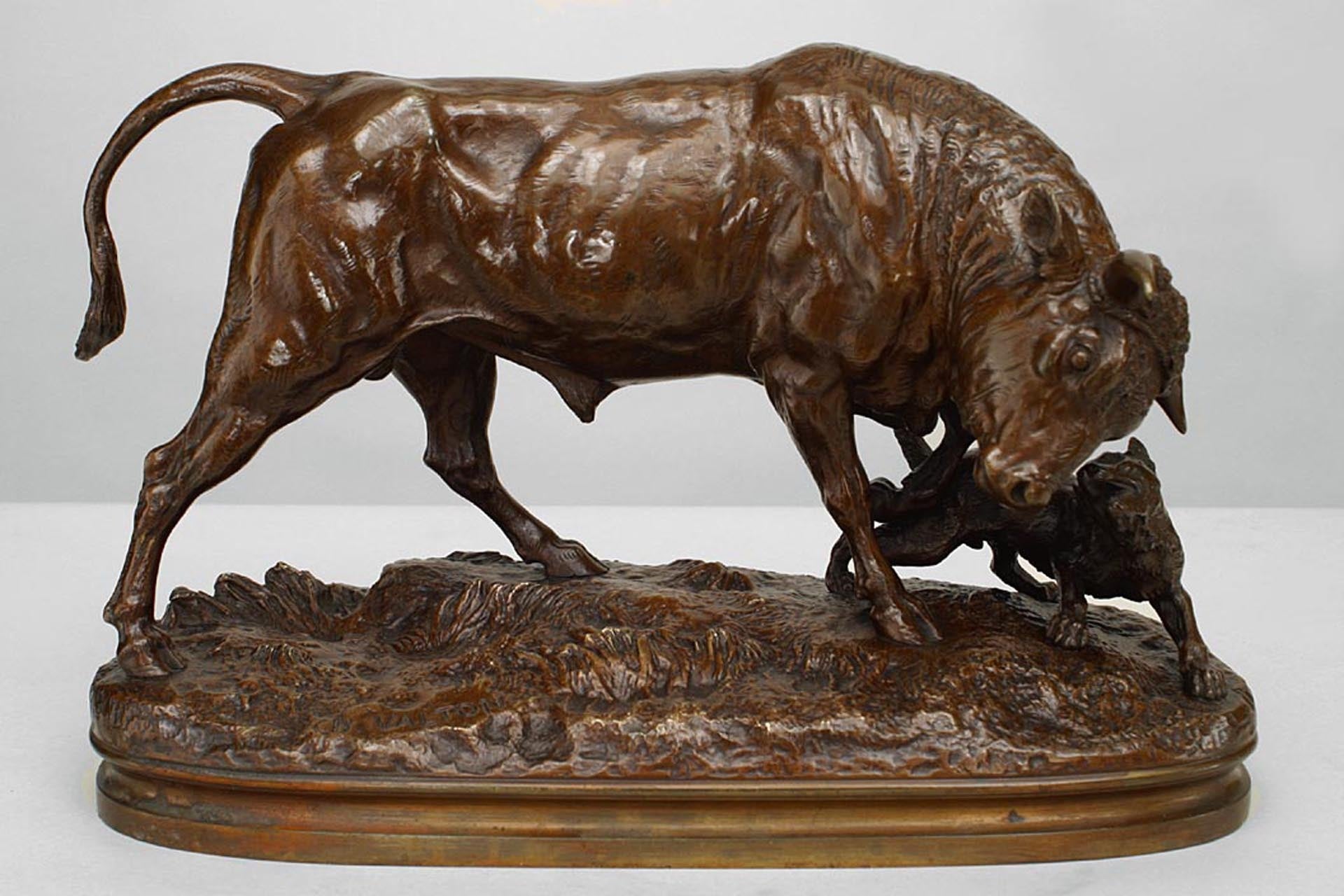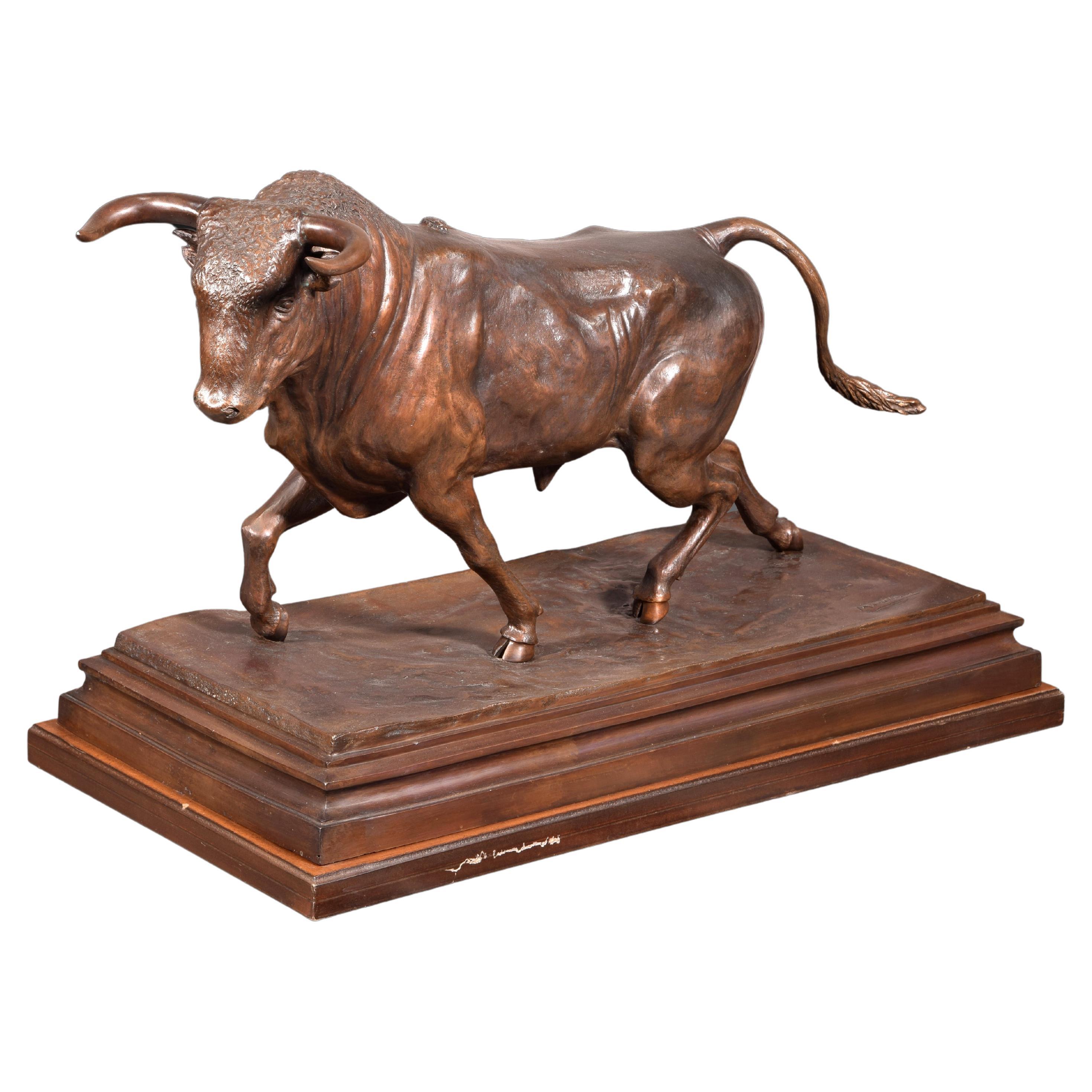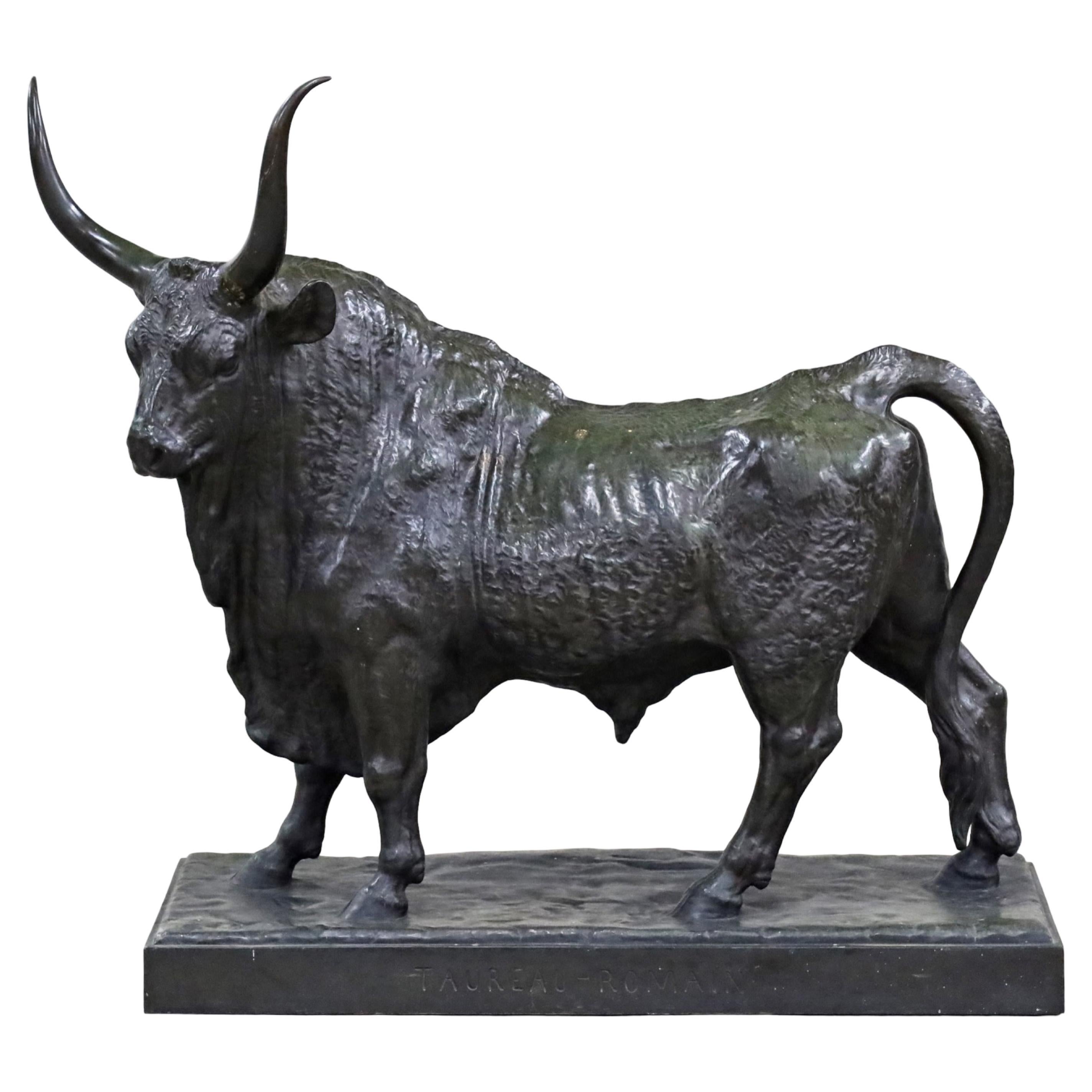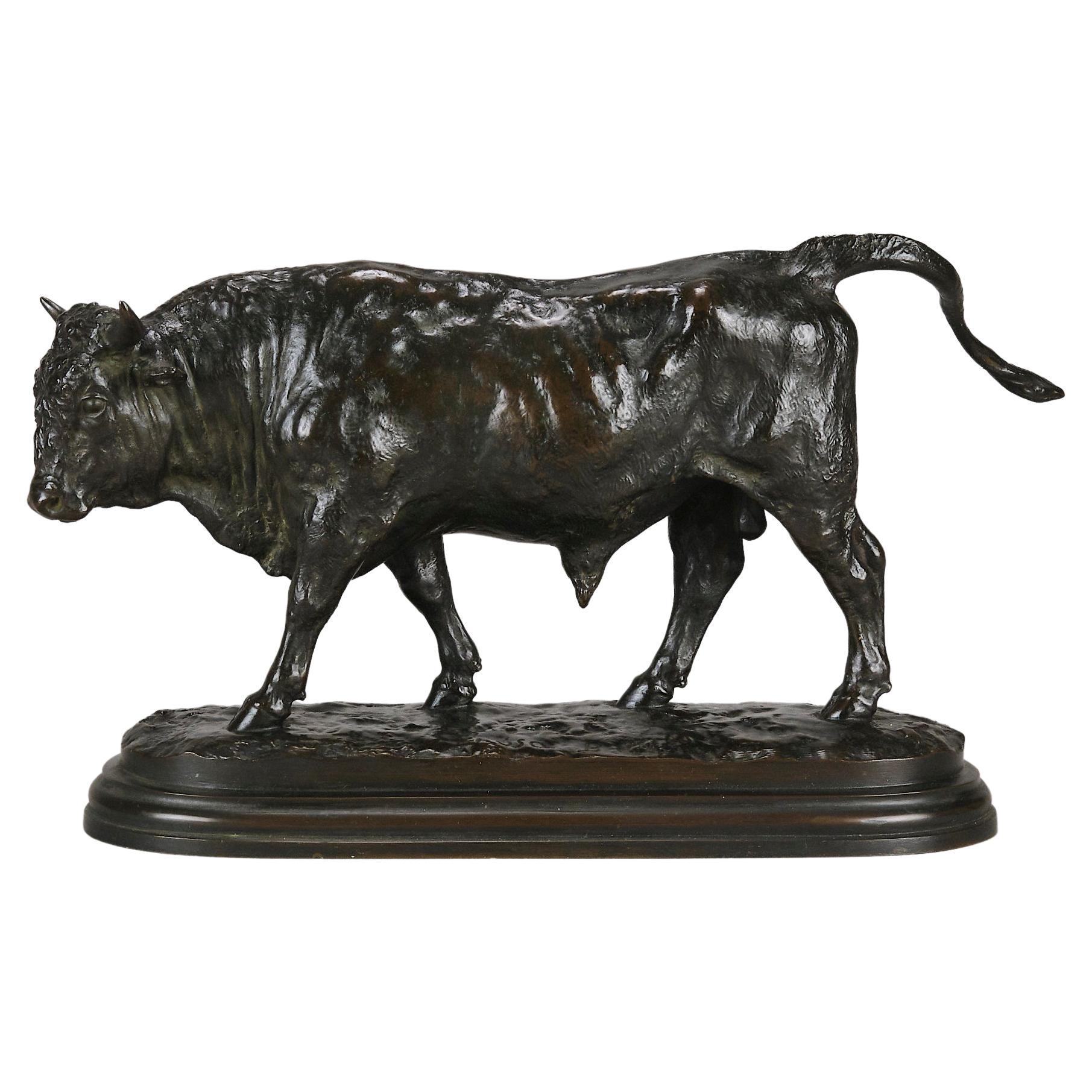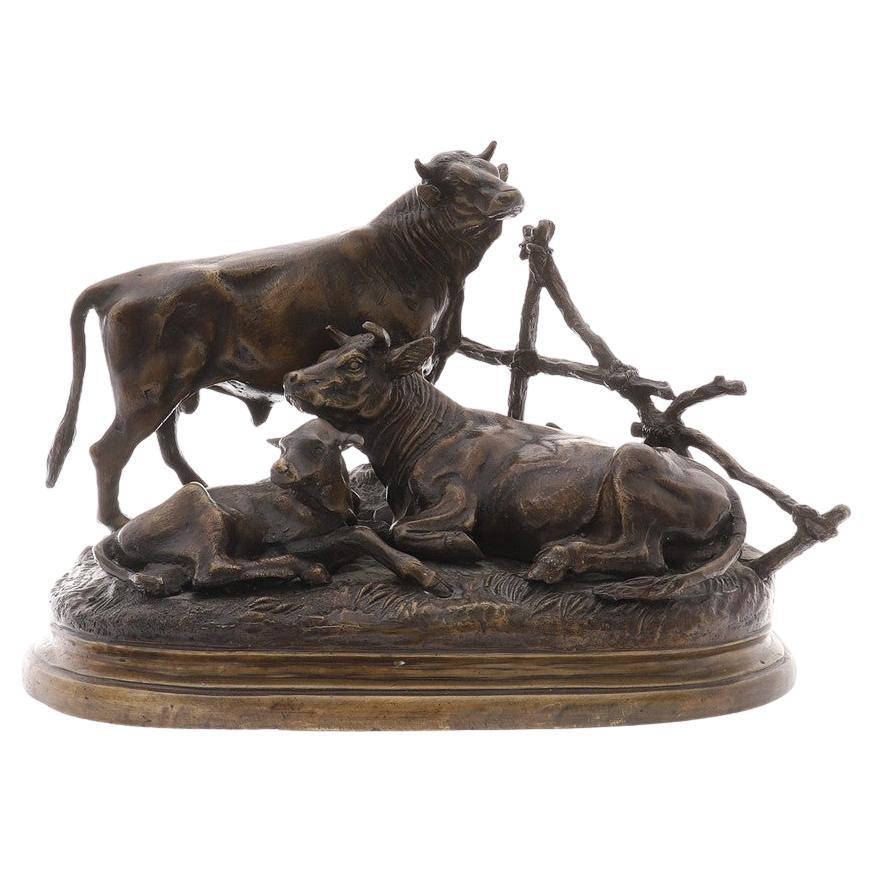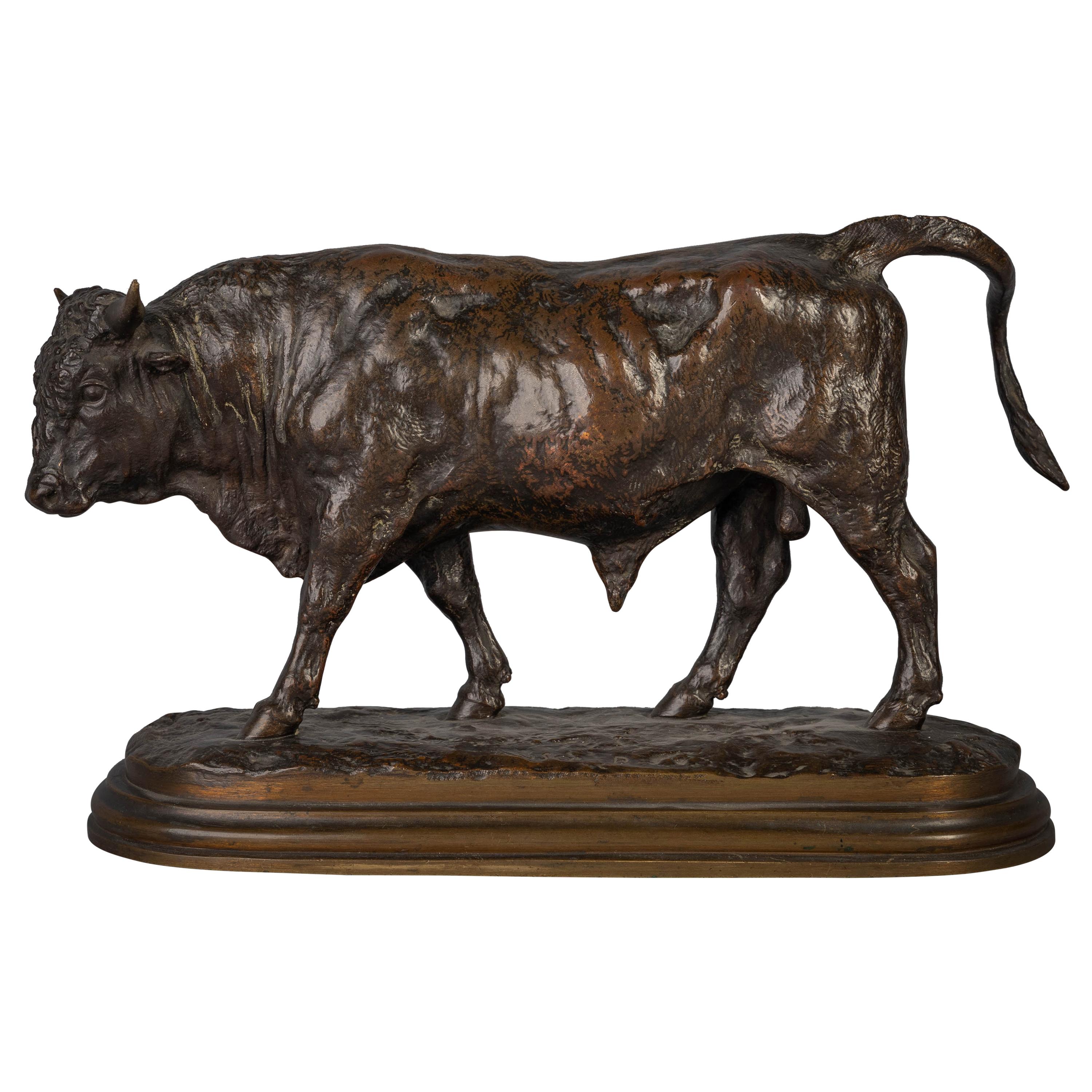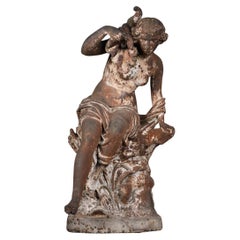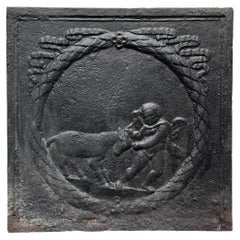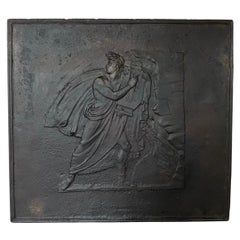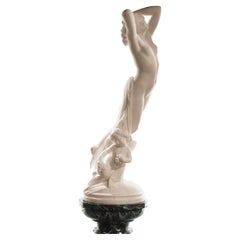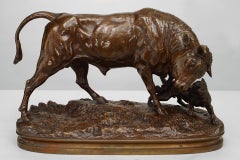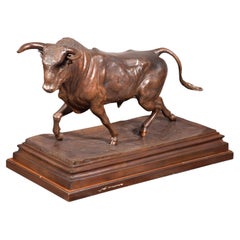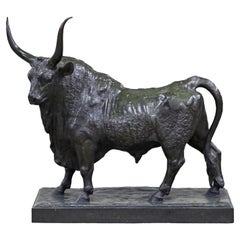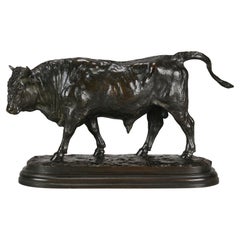Items Similar to Christophe FRATIN (1801-1864), Taureau à la grenouille (A Bull With a Frog)
Want more images or videos?
Request additional images or videos from the seller
1 of 12
Christophe FRATIN (1801-1864), Taureau à la grenouille (A Bull With a Frog)
$29,269.05
£21,344.34
€24,500
CA$40,039.47
A$44,805.29
CHF 23,395.22
MX$550,834.42
NOK 295,157.64
SEK 277,741.89
DKK 186,444.56
Shipping
Retrieving quote...The 1stDibs Promise:
Authenticity Guarantee,
Money-Back Guarantee,
24-Hour Cancellation
About the Item
Between 1839 and 1849 (?)
Chef-modèle made out of patinated bronze, base in Rouge Griotte marble.
Signed « Fratin », « Fonderie de L. Richard Eyck et Durand » engraved on the base.
Dimensions : L. 47 cm / 18’’ 1/2 ; H. 23 cm / 9’’ 1/16 ; P. 26 cm / 10’’ 1/4
REF. 11386
This sculpture was made out of bronze during the 19th century by the famous animal sculptor Christophe Fratin. It represents a young bull moving and more specifically chasing the little frog it has on his back. An other amphibian is set on the base.
The reason why this sculpture has so many sharp details is that it is a chef-modèle (original mould) allowing the reproduction of the sculpture in order to produce commercial copies. Indeed, the details lose their quality during the overmoulding process so the chef-modèle is sculpted so as to prevent this loss. When the piece is not meant to be cast in one go, it has to be dismantle so there are bolts which link the different parts of the piece as is the case here. The quality of the beautiful brown patina should be underlined.
After the 1848 Revolution, the downturn of the art market forces Fratin to sell his works during auctions, most of the time with their publishing rights which is extremeley rare for a 19th century’s sculptor. Our sculpture has been reassembled with the bolts which were added for the purpose of the sale. We don’t know any copy that would have been made from this chef-modèle, making it particularly unique. In the catalogue of one of these auctions (in July 1849), a « Taureau à la grenouille » (Bull With a Frog) is mentioned, so we can date our sculpture from before 1849.
- Creator:Christophe Fratin (Artist)
- Dimensions:Height: 9.06 in (23 cm)Width: 18.51 in (47 cm)Depth: 10.24 in (26 cm)
- Style:Romantic (Of the Period)
- Materials and Techniques:
- Place of Origin:
- Period:
- Date of Manufacture:Between 1839 and 1849
- Condition:
- Seller Location:SAINT-OUEN-SUR-SEINE, FR
- Reference Number:Seller: 113861stDibs: LU7662242390492
About the Seller
No Reviews Yet
Recognized Seller
These prestigious sellers are industry leaders and represent the highest echelon for item quality and design.
1stDibs seller since 2022
Typical response time: 8 hours
- ShippingRetrieving quote...Shipping from: SAINT-OUEN-SUR-SEINE, France
- Return Policy
Authenticity Guarantee
In the unlikely event there’s an issue with an item’s authenticity, contact us within 1 year for a full refund. DetailsMoney-Back Guarantee
If your item is not as described, is damaged in transit, or does not arrive, contact us within 7 days for a full refund. Details24-Hour Cancellation
You have a 24-hour grace period in which to reconsider your purchase, with no questions asked.Vetted Professional Sellers
Our world-class sellers must adhere to strict standards for service and quality, maintaining the integrity of our listings.Price-Match Guarantee
If you find that a seller listed the same item for a lower price elsewhere, we’ll match it.Trusted Global Delivery
Our best-in-class carrier network provides specialized shipping options worldwide, including custom delivery.More From This Seller
View AllDucel Foundry after Pierre Loison, Young Girl with a Conch, mid-19th century
By Pierre Loison 1, J.J. Ducel
Located in SAINT-OUEN-SUR-SEINE, FR
This statue, titled Young Girl with a Conch, was cast by the Ducel Foundry after a work by Pierre Loison in the mid-19th century.
The sculptor Pierre Loison (or Loyson) (1816-1886) began his career as an apprentice to a clog maker. Noticed for his talent, he was able to study sculpture in the studio of David d’Angers and at the École des Beaux-Arts in Paris. He received numerous official commissions and exhibited in nearly every Salon from 1845 until 1886, the year of his death, as well as at the 1855 Universal Exhibition.
The Ducel Foundry was founded in 1800 in Touraine. It was successively managed by three generations of the Ducel family: Jacques, Jean-Jacques, and Jacques-Gustave. The company had a store in Paris and gained recognition by participating in various international exhibitions held in the second half of the 19th century. It was purchased by the Val d’Osne Foundry in 1878.
This sculpture depicts a young girl seated on a rock by the water’s edge. She may represent a naiad, a deity associated with rivers and springs. Her posture conveys movement, as if she is about to enter the water: her face and torso lean forward, she holds onto the rock with her left hand, and in her right hand, she grasps a conch shell, which could emit a jet of water. A drapery covers her waist, and both legs extend toward the water.
The statue bears an inscription on the base indicating its origin: “JJ DUCEL...
Category
Antique Mid-19th Century French Napoleon III Statues
Materials
Iron
Fireback from the 18th Century Featuring a Love Playing with a Goat
Located in SAINT-OUEN-SUR-SEINE, FR
Very unusual and rare 18th century fireback, figuring a love playing with a goat..
Category
Antique 18th Century French Louis XV Fireplace Tools and Chimney Pots
Materials
Iron
Fireback " Apollo with the lyre"
Located in SAINT-OUEN-SUR-SEINE, FR
This fireback was made in the 19th century of cast iron. It is adorned with a representation of the god Apollo that we recognize thanks to the lyre he's holding in his hands.
Category
Antique Mid-19th Century European Classical Greek Architectural Elements
Materials
Iron
Marble Sculpture and Its Original Column, 19th Century
By Joseph Pollet
Located in SAINT-OUEN-SUR-SEINE, FR
This amazing sculpture in Carrara marble was made around 1850 by the French sculptor Joseph Michel-Ange Pollet, after one of his plaster models presented at the Salon de Paris in 184...
Category
Antique 19th Century French Napoleon III Figurative Sculptures
Materials
Marble, Carrara Marble
Monumental Fireplace Signed by Jules Allard and Louis Ardisson
Located in SAINT-OUEN-SUR-SEINE, FR
Located in the hall of a ballroom, this exceptional fireplace welcomed the 80 guests of Edward Julius Berwind's luxurious New York home in the Louis XV style. It attests to the true ...
Category
Antique Late 19th Century French Napoleon III Fireplaces and Mantels
Materials
Marble, Breccia Marble, Carrara Marble
Set clock with Marie de Bourgogne going falcon hunting
By Jean-Auguste Barre
Located in SAINT-OUEN-SUR-SEINE, FR
This important silvered bronze, gilded bronze and white Statuary marble clock set was probably made around 1840-1844. The central group is depicting Mary of Burgundy on a falcon hunt...
Category
Antique 19th Century French Renaissance Revival Mantel Clocks
Materials
Marble, Bronze
You May Also Like
French Bronze Bull and Dog
By Charles Valton
Located in Queens, NY
French bronze figure of bull with attacking dog on an oval base (Valton) (19/20th Cent.)
Category
Antique 19th Century French Animal Sculptures
Materials
Bronze
$12,000
Bull, Bronze, After Benlliure Gil, Mariano
By Mariano Benlliure y Gil
Located in Madrid, ES
Bull. Bronze. Following the model of BENLLIURE GIL, Mariano (Valencia 1862-Madrid, 1947).
Mariano Benlliure was a Spanish sculptor, a precocious cr...
Category
20th Century Spanish Other Animal Sculptures
Materials
Bronze, Other
Jean-Baptiste Clesinger (French, 1814-1883) Taureau Romain
Located in Dallas, TX
Large bronze model of Taureau Romain, the Roman bull, by Jean-Baptiste Clesinger (French, 1814-1883), rich verde bronze patina, cast by F. Barbedienne Foundeur, marked on base, stamp...
Category
Antique Mid-19th Century French Animal Sculptures
Materials
Bronze
19th Century Animalier French Bronze Entitled "Taureau Debout" by Rosa Bonheur
By Rosa Bonheur
Located in London, GB
"Taureau Debout" by Rosa Bonheur.
An excellent late 19th Century French animalier bronze study of a standing bull with fine hand chased surface that accentuates the muscle definition of the subject, signed Rosa B.
ADDITIONAL INFORMATION
Measures: Width: 32 cm
Height: 18 cm
Depth: 11cm
Condition: Excellent Original Condition
Circa: 1870
Materials: Bronze
Book reference: Animals in Bronze by Christopher Payne
Page no. 174
DESCRIPTION
Bonheur, Rosa (1822-1899)
The most popular artist of nineteenth-century France, Rosa Bonheur was also one of the first renowned painters of animals and the first woman awarded the Grand Cross by the French Legion of Honor. A professional artist with a successful career, Bonheur lived in two consecutive committed relationships with women.
Born on March 16, 1822 in Bordeaux, Marie Rosalie Bonheur was the oldest of the four children of Raimond Oscar Bonheur (1796-1849) and Sophie Marquis. Bonheur's father was an art teacher who came from a poor family, while her mother, a musician, had descended from a middle-class family and had been her husband's art student.
Bonheur's father, who taught drawing and landscape painting, was an ardent member of the utopian Saint Simeon society.
The group held idealistic beliefs about the reform of work, property, marriage, and the role of women in society. Most importantly, for the artist's future, the Saint Simeons questioned traditional gender norms and firmly believed in the equality of women. While teaching artistic techniques to his oldest daughter, Raimond Bonheur also encouraged her independence and taught her to consider art as a career.
In 1828 Raimond Bonheur joined the Saint Simeons at their retreat outside Paris. Sophie and the children joined him in Paris the following year. Four years later, however, Raimond abandoned his family to live in isolation with his fellow Saint Simeons.
Sophie Bonheur died in 1833 at the age of thirty-six. Rosa was only eleven years old when her mother died, but she was aware of the heavy price her mother paid for married life with a man who was more dedicated to his own ideals than to meeting his family's needs. Rosa also saw that her mother's marriage led to poverty and her death from exhaustion.
After her mother's death, Bonheur was taken in by the Micas family who resided nearby. Mme Micas and Bonheur's mother had been friends. When Mme Bonheur died, the Micas family paid Raimond Bonheur's debts and cared for Rosa. Their daughther, Nathalie, who would later become an amateur inventor and unschooled veterinarian, and Rosa became enamored with each other.
When Rosa Bonheur began her career as a professional artist, she had already been trained by her father who had allowed her to study in all male classes. Rosa also learned by sketching masterworks at the Louvre from the age of fourteen, and later, by studying with Léon Cogniet.
From the very beginning, Bonheur's favorite subject was animals. She learned their anatomy completely by dissecting them in local slaughterhouses. She also visited the horse market two times a week. Study of animals by direct observation led to the formation of the realist style in which Bonheur worked.
It was for such work that Bonheur obtained written permission from the French government to wear men's slacks. Her working attire also consisted of a loose smock and heavy boots that protected her feet from the dangerous environment in which she painted. The style of dress that the artist adopted for work and home may well have been influenced by her father's attire, which was based on St. Simeonian clothing experiments. Bonheur also cropped her hair, perhaps to facilitate her work. She did, however, always wear dresses for social occasions because she knew that appropriate dress would further her career.
Bonheur earned a successful living as a painter of animals. She exhibited at the annual Paris Salon regularly from the age of nineteen in 1841 through 1853, when she was thirty-one. She won the salon's gold medal at the age of twenty-six in 1848 and was commissioned by the French government to paint Plowing on the Nivernais in 1849. In the same year Bonheur and her sister Juliette became directors of l'École gratuite de dessin pour les jeunes filles, a post their father had once held.
Bonheur completed her most renowned work, The Horse Fair, in 1855. The successful representation of percherons (a breed native to Normandy) was purchased by Ernest Gambart, a London art dealer whose gallery specialized in work by French artists. He exhibited The Horse Fair in London where Bonheur visited with Nathalie. Queen Victoria requested a private viewing of the painting at Windsor Castle. It would later be purchased in 1887 by Cornelius Vanderbilt and donated to the new Metropolitan Museum of Art in New York City.
Bonheur's trip to England allowed her to meet Charles Eastlake, then President of the Royal Academy, John Ruskin, the English writer and critic, and Edwin Landseer, the British animalier. She also toured the English and Scottish countrysides and executed some paintings based on her observations of new breeds of animals found there.
Gambart made engravings of Bonheur's work, including The Horse Fair, and sold them in England, Europe, and the United States. Bonheur became one of the most renowned painters of the time. Little girls, such as Anna Klumpke in the United States, even had dolls in her likeness, much as American girls played with Shirley Temple dolls...
Category
Antique 19th Century French Art Nouveau Animal Sculptures
Materials
Bronze
Decorative Bronze Figure of a Bull, Home Decor Objects After Jules Moigniez
Located in Wembley, GB
An artistically created sculpture table decorative objects, After Jules Moigniez (French 1835-1894), bronze figure group modelled as a bull, cow and calf on the naturalistically modelled ground before a fence, upon an oval base, signed J Moigniez.
This bronze with a brown patina, entitled “Bovine family...
Category
Antique Early 1800s French Art Deco Sculptures and Carvings
Materials
Bronze
$2,685 Sale Price
48% Off
Free Shipping
French Bronze Figure of a Bull, by Rosa Bonheur
Located in New York, NY
Inscribed "Rosa B" and stamped with the "Peyrol" foundry on the base.
Category
Antique 1860s Animal Sculptures
Materials
Bronze
More Ways To Browse
Auction Catalogues
4 Frogs
Rimini Blu Horse 1960
Robert Maxwell Critter
Rosenthal Porcelain Kunstabteilung Handgemalt Figurines
Royal Copenhagen Rooster
Royal Dux Owl
Ruscha Bull
Sascha Brastoff Horses
Seguso Squirrel
Senufo Bird Carving
Sergio Bustamante Peacock
Sheep Footrest
Siamese Cat Ceramic
Sier Kunst
Snail Mother Of Pearl Light
Soapstone Pig
Spaghetti Poodle
